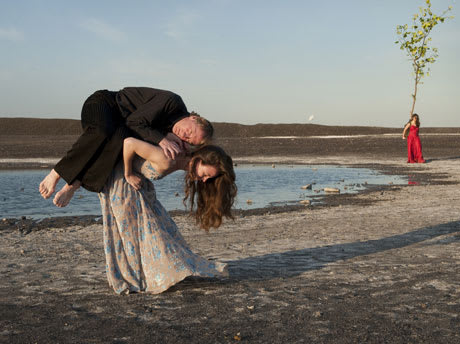Hot on the heels of Werner Herzog's Cave of Forgotten Dreams, Wim Wenders is the latest titan of world cinema (no, Michael Bay doesn't count) to embrace the fancy-schmancy world of 3-D. While Herzog eschewed jive-talking robots for the ancient cave paintings of Chauvet, France, Wenders' high art third-dimensional foray is into the world of dance, particularly the work of late choreographer Pina Bausch.
But while Bausch is only shown fleetingly, her work is recreated by dancers (many of whom she worked with regularly throughout her career), allowing her essentialist philosophy of "dance, dance, otherwise we are lost" to be realized in full glory.
Originally intending the project as a biographical documentary, until Bausch's passing, Wenders puts her kinetic, almost violent choreography on display in a number of different venues, both indoors and outdoors, on the stage and in the middle of nowhere. While 3-D still looks like a gimmick to these eyes, lovers of dance will certainly be enthralled with Wenders' compositions, which are immersive and rarely ostentatious.
Wenders intercuts the performance pieces with first-person interviews of dancers young and old ruminating on the meaning of the work and reminiscing about Bausch's personality and how it was inextricably infused into her choreography.
Wenders has always been a master stylist and Pina is no exception. The dance pieces are meticulously recreated and compelling. Wenders seamlessly unites the pieces and brings the common aesthetic into relief. That said, the more personal and human aspects of Bausch's life are left mostly unexamined.
This is largely a performance film, and is better suited for dance aficionados (is there such a thing as dance nerds?) looking to experience the art form through another set of virtual eyes.
(Mongrel Media)But while Bausch is only shown fleetingly, her work is recreated by dancers (many of whom she worked with regularly throughout her career), allowing her essentialist philosophy of "dance, dance, otherwise we are lost" to be realized in full glory.
Originally intending the project as a biographical documentary, until Bausch's passing, Wenders puts her kinetic, almost violent choreography on display in a number of different venues, both indoors and outdoors, on the stage and in the middle of nowhere. While 3-D still looks like a gimmick to these eyes, lovers of dance will certainly be enthralled with Wenders' compositions, which are immersive and rarely ostentatious.
Wenders intercuts the performance pieces with first-person interviews of dancers young and old ruminating on the meaning of the work and reminiscing about Bausch's personality and how it was inextricably infused into her choreography.
Wenders has always been a master stylist and Pina is no exception. The dance pieces are meticulously recreated and compelling. Wenders seamlessly unites the pieces and brings the common aesthetic into relief. That said, the more personal and human aspects of Bausch's life are left mostly unexamined.
This is largely a performance film, and is better suited for dance aficionados (is there such a thing as dance nerds?) looking to experience the art form through another set of virtual eyes.
